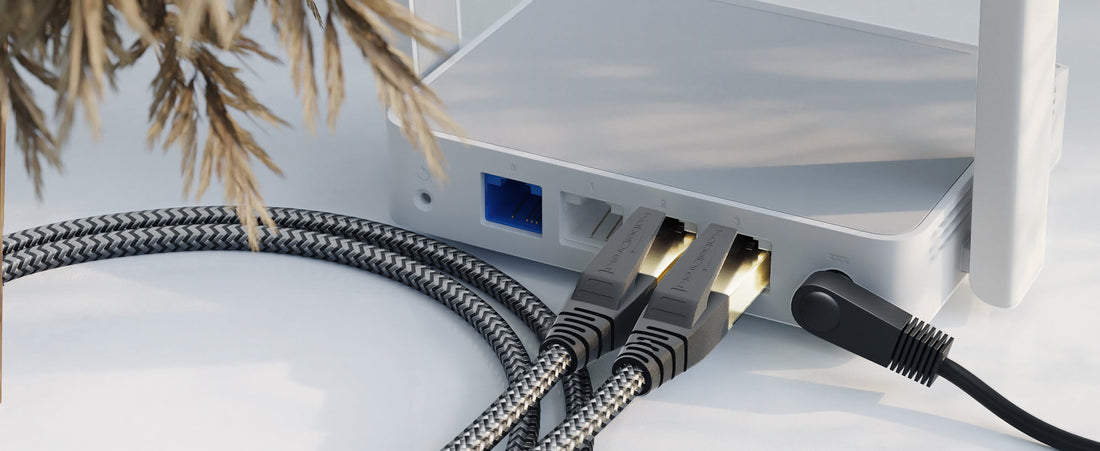
POWERLINE, WiFi OR ETHERNET?
Share

In times of home office, streaming, and smart home, stable and fast internet connections throughout the household are more important than ever. But which technology is the best choice for efficiently building or expanding your home network?
Should you rely on classic network cables (Ethernet), wireless Wi-Fi, or Powerline adapters that distribute the internet via the power lines? In this article, you will learn everything you need to know about these three technologies, their advantages and disadvantages, and receive helpful tips for making the right decision.
Network Cable: The Classic for Maximum Stability
The network cable, also known as Ethernet cable, is still the first choice when it comes to maximum speed and reliability.
Advantages:
- Very high transmission speeds (up to 10 Gbit/s and more with Cat7 or Cat8 cables)
- Extremely low latency – ideal for gaming, 4K/8K streaming, and large amounts of data
- Unaffected by interference factors such as walls, ceilings, or electromagnetic radiation
Disadvantages:
- More complex installation over long distances, especially in existing buildings
- Visible cables or costly in-wall or under-plaster installations
Whenever structural conditions allow, wired connections are always the best choice for a stable network connection.
Wi-Fi: Flexible and Essential for Mobile Devices
Wi-Fi (Wireless Local Area Network), often simply called WiFi, offers a wireless connection to the internet and is particularly convenient for mobile devices such as smartphones, tablets, or laptops.
Advantages:
- Easy to install
- No cables required
- High speeds with modern standards (Wi-Fi 6, Wi-Fi 6E, Wi-Fi 7)
Disadvantages:
- Signal loss through walls and ceilings
- Susceptible to interference from other wireless networks or household appliances
- Fluctuating connection speeds and latency
A powerful Wi-Fi network is indispensable in most households today but should be optimally set up to fully exploit its advantages.
Powerline: Internet via Electrical Outlets
Powerline adapters use the existing electrical wiring in the house to transmit network data. Especially in homes where Wi-Fi coverage is poor and cable installation is not feasible, Powerline offers a practical alternative.
Advantages:
- Easy installation via existing power sockets
- Bridges long distances in the house
- Can be combined with Wi-Fi access points
Disadvantages:
- Performance loss with poor wiring quality or old installations
- Interference from electrical devices such as power supplies, refrigerators, or washing machines
- Different power circuits and phase jumps can limit functionality
- Actual data rates often significantly lower than advertised
Powerline is particularly interesting when structural conditions prevent clean cabling or stable Wi-Fi.
Additional Notes for Your Decision
- Repeater: Wi-Fi repeaters can extend the range of Wi-Fi but often halve the speed.
- Mesh Systems: A modern alternative to repeaters that offers a unified network with better speed and range.
- Powerline Wi-Fi Adapters: Practical combinations that supply both wired and wireless devices.
- Security: Modern Powerline adapters usually encrypt transmission (AES-128), but they should be correctly paired during initial setup.
Questions and Answers about Powerline, Wi-Fi, and Network Cables
Can you use Wi-Fi and Powerline simultaneously?
Yes, this is easily possible. Many Powerline adapters even have integrated Wi-Fi access points. This allows you to build a new Wi-Fi network via the power line while simultaneously connecting devices via LAN cables.
Is Powerline better than a repeater?
It depends on the circumstances. In buildings with thick walls or long distances, Powerline can often provide a more stable connection than a simple Wi-Fi repeater. Repeaters also halve the transmission rate, which Powerline adapters do not.
What is the difference between a repeater and a mesh repeater?
A classic Wi-Fi repeater merely amplifies the signal of an existing network, often halving the bandwidth in the process. A mesh repeater is part of an intelligent mesh network that automatically connects devices to the best access point and enables an almost uninterrupted connection.
What is the difference between Powerline, PowerLAN, and DLAN?
All three terms basically describe the same thing: the use of electrical wiring for data transmission. "PowerLAN" is an alternative term for Powerline. "dLAN" (direct LAN) is a brand term coined by the company devolo for Powerline technology.
Conclusion: The Right Choice for Your Network
Which technology is right for you strongly depends on your individual conditions and requirements. Wherever possible, you should rely on network cables – especially for stationary devices such as PCs or smart TVs. Wi-Fi remains indispensable for mobile devices and can be significantly improved with mesh systems. Powerline is an excellent solution when structural barriers limit Wi-Fi range and cabling is not practical.
By cleverly combining the strengths of different technologies, you can create a powerful and stable home network – perfect for streaming, working from home, and the smart home.
